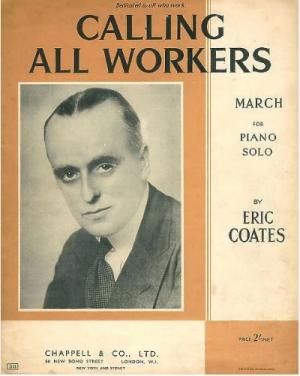Calling All Workers
(Eric Coates)
Analysed by Robert
Walton
 Eric Coates
wasn’t called the first
English King of light music for
nothing. He was a superb
craftsman, brilliant orchestrator
but more importantly his personal
flare for melody put him in a
class of his own. His
irresistible tunes were simple
and direct and always passed the
ultimate test - they could be
whistled. In modern terms they
were 'commercial'. Like 'The
Waltz King' Johann Strauss
Junior, Coates made an art form
out of light music by giving it
the sort of credibility classical
music enjoyed. How did he
accomplish all this? By first
immersing himself as a performer
in serious music in the early
part of the 20th century. During
his time as principal violist
with the Queen's Hall Orchestra
(from 1912) he was absorbing all
styles of music as well as being
in the unique position of
learning about baton technique
and interpretation from the great
conductors and performers of the
period. Effectively he attended
continuous free lectures at the
"university" of the
orchestra, but always with an eye
on, and indeed an ear for,
writing lighter music. Like many
young would-be composers he felt
he could produce works as good,
if not better, than some of those
he was playing. And he was
probably right. As early as 1915
he had written a suite From
the Countryside. So the
scene was set for what turned out
to be one of the most remarkable
careers in light music. Eric Coates
wasn’t called the first
English King of light music for
nothing. He was a superb
craftsman, brilliant orchestrator
but more importantly his personal
flare for melody put him in a
class of his own. His
irresistible tunes were simple
and direct and always passed the
ultimate test - they could be
whistled. In modern terms they
were 'commercial'. Like 'The
Waltz King' Johann Strauss
Junior, Coates made an art form
out of light music by giving it
the sort of credibility classical
music enjoyed. How did he
accomplish all this? By first
immersing himself as a performer
in serious music in the early
part of the 20th century. During
his time as principal violist
with the Queen's Hall Orchestra
(from 1912) he was absorbing all
styles of music as well as being
in the unique position of
learning about baton technique
and interpretation from the great
conductors and performers of the
period. Effectively he attended
continuous free lectures at the
"university" of the
orchestra, but always with an eye
on, and indeed an ear for,
writing lighter music. Like many
young would-be composers he felt
he could produce works as good,
if not better, than some of those
he was playing. And he was
probably right. As early as 1915
he had written a suite From
the Countryside. So the
scene was set for what turned out
to be one of the most remarkable
careers in light music.
Fast-forward 25
years to 1940 when as an
established composer, Coates
penned Calling all Workers,
the signature tune of "Music
While You Work". A short
fanfare heralds one of his best
known marches and indeed what is
now regarded as one of the most
famous orchestral marches of all
time. Strangely it never quite
worked when arranged for brass
band. I don’t know whether
he intended to have a lyric, but
how about these words for
openers? "Now the BBC is
Calling all Workers today, to be
part of the music and fun all the
way!" I can’t think of
a snappier march than this
toe-tapping tune to keep up the
morale of the wartime workforce.
But we have to
wait for the second theme to
discover the real Eric Coates.
Cheerful, syncopated and positive
though the opening was, this
smooth joyous melody tugs at your
heartstrings in a way that no
other composer quite achieved and
fits perfectly in the context of
the march. Taking a leaf out of
the Elgar songbook, Coates
captures the indomitable spirit
of the British people with a
tearful tune the whole nation and
the free world could relate to.
But was it entirely his own? I
have a theory he may have been
influenced by Mendelssohn's
Violin Concerto in E minor,
albeit indirectly. (I was once
accused of copying the same bit
for my Bells of Old London
which up until then I had never
heard. More likely my song was
influenced by Coates!). Then the
strings becoming decorators play
second fiddle to the brass who
blaze away with the melody in a
more high profile presentation.
Back to the top
for the final chorus of this
Coates classic and on reaching
the moving second theme he
achieves a truly triumphant
effect by slowing it right down,
eventually bringing it to a
complete stop. This is an
excellent example of a
"thinking" composer
using his classical background to
make the most of tempo changes.
For the third time the fanfare is
incorporated, announcing a
spectacular finish.
Long after that
sparkling finale has faded away,
it’s that haunting melody
with ballad-like overtones which
lingers in the memory. And
interestingly, Coates' musical
heir Robert Farnon made no
apologies for being inspired by
the older composer's tender march
themes, a tradition surprisingly
started by Wagner.
|